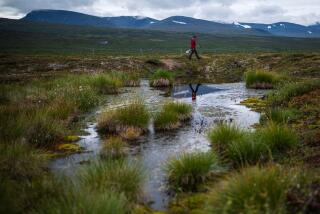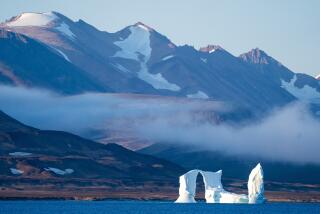Want to cut Arctic warming in half? Curb emissions now, study says

- Share via
Global warming is changing the Arctic so quickly that experts say we should expect an ice-free Arctic Ocean in the summer within just a few decades.
But a group of scientists says there is a way to spare the Arctic from more disastrous climate change. In a new paper, they say that reducing global carbon emissions now could cut Arctic warming nearly in half by century’s end.
Society already has released enough carbon dioxide into the Earth’s atmosphere that over the next few decades temperatures in the Arctic will continue to rise two to three times faster than in Earth’s middle latitudes, according to the study.
“Over the next 20 or 30 years, the fix is in,” said James Overland, an oceanographer at the National Oceanic and Atmospheric Administration and lead author of the scientific paper. “That means more access to drilling, shipping and resource exploration. But it’s not very good news for polar bears or walruses that depend on the sea ice habitat.”
Starting mid-century, society’s decisions about how to address climate change could begin to kick in, Overland said.
If carbon emissions continue on their current trajectory, by century’s end temperatures across the Arctic could rise by 23.4 degrees in the late fall and 9 degrees in the late spring, according to the study, which used computer models to predict the effects of different greenhouse gas emissions scenarios.
But if civilization levels off its emissions by mid-century, Arctic-wide warming would be limited to 12.6 degrees in the late fall and 5.4 degrees in the late spring, according to the paper accepted for publication in the journal Earth’s Future.
The Arctic is hypersensitive to climate change and is seeing some of the earliest and most severe effects because of a vicious circle known as “Arctic amplification.”
As Arctic sea ice shrinks to record lows, it is reflecting less sunlight and leaving behind more heat-absorbing ocean water. Thawing permafrost is increasing heat storage on land and raising temperatures even higher.
Already, the average annual temperature in the Arctic is 3.6 degrees higher than it was between 1971 and 2000, double the rise in lower latitudes during the same period, according to the study.
Overland conducted the research with three other scientists from the University of Washington, the National Snow and Ice Data Center in Boulder, Colo., and the International Arctic Research Center at the University of Alaska Fairbanks.
The scientists wrote that their research “makes a strong case to begin mitigation activities for greenhouse gases,” adding that stabilizing carbon dioxide emissions by mid-century “is a plausible target if decisive actions are begun soon.”
Twitter: @tonybarboza







